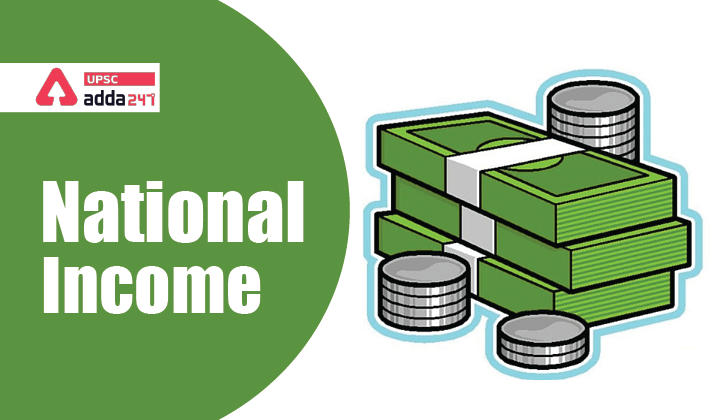Table of Contents
National Income and Related Aggregates: Relevance
- GS 3: Indian Economy and issues relating to planning, mobilization, of resources, growth, development and employment.
What is National income?
- National Income of a country means the final value of the goods and services produced by the country during its financial year. Generally, it is valued in terms of money. It is also helpful in determining the progress of the country.
- National income is a combination of wages, interest, rent, profit, which are received by factors of production like labour, capital, land and entrepreneurship respectively.
- National income includes gross and net national income, savings or net lending/net borrowing.
National Income and Related Aggregates: National income measurement
National Income can be calculated in three ways
- Income Method
- Product/ Value Added Method
- Expenditure Method
National income by Income method
- In this method, national income is calculated by adding all the factors of production (rent, wages, interest, profit) and the mixed-income of self-employed.
National income by Product/ Value Added Method
- In this method, national income is calculated by adding the value added, in terms of money, by all the firms.
- Value added can be defined as,
- Value-added = Value of Output – Value of (non-factor) inputs
- This gives GDP at Market Price (MP), because it includes depreciation (therefore ‘gross’) and taxes (therefore ‘market price’)
- To reach National Income (that is, NNP at FC)
- Add Net Factor Income from Abroad: GNP at MP = GDP at MP + NFIA
- Subtract Depreciation: NNP at MP = GNP at MP – Dep
- Subtract Net Indirect Taxes: NNP at FC = NNP at MP – NIT
National income by Expenditure Method
- Under this method, national income can be understood by the equation given below:
- Y = C + I + G + (X-M)
Where,
- C = Consumption (Household consumption expenditures / Personal consumption expenditures)
- I = Investment / Gross private domestic investment
- G = Government spending (Government consumption / Gross investment expenditures)
- X = Net Exports (Gross exports of goods and services)
- M = Net Imports (Gross imports of goods and services)
Note: (X – M) is often written as XN or less commonly as NX, both stand for “net exports”.
National Income and Related Aggregates: National Income concept
- There are various concepts associated with National Income that includes GDP, GNP, NDP, NNP. Let us understand these concepts in detail
GDP
- GDP means Gross Domestic Product. Gross domestic product (GDP) can be defined as the value of all final goods and services produced in a country in one year.
- GDP (gross domestic product) at market price = value of output in an economy in the particular year minus intermediate consumption.
- GDP at factor cost = GDP at market price minus depreciation plus NFIA (net factor income from abroad) minus net indirect taxes.
Gross national product (GNP)
- Gross national product (GNP) is defined as the market value of all goods and services produced in one year by labour and property supplied by the residents of a country
- So, GNP can be defined as GDP plus net receipts from abroad of compensation of employees, property income and net taxes less subsidies on production.
Mathematically,
- GNP=GDP+NFIA or,
- GNP=C+I+G+(X-M) +NFIA
Net National Product (NNP)
- Net National Product (NNP) is the market value of net output of final goods and services produced by a country during a financial year and net factor income from abroad.
Mathematically,
- NNP=GNP-Depreciation
- or, NNP=C+I+G+(X-M) +NFIA- IT-Depreciation
Net National Product (NNP)
- NNP defined as gross national product minus the depreciation of fixed capital assets (dwellings, buildings, machinery, transport equipment and physical infrastructure) through wear and tear and obsolescence.
- National income can be defined as follows:
- NI=NNP +Subsidies-Interest Taxes
- Hence, the sum of the income received by factors of production in the form of rent, wages, interest and profit is called National Income.
Personal Income (PI)
- Personal Income can be defined as the total money income received by individuals and households of a country through all possible legitimate sources before direct taxes.
- Mathematically, personal income can be expressed as:
- PI=NI-Corporate Income Taxes-Undistributed Corporate Profits- Social Security Contribution +Transfer Payments.
Disposable Income (DI)
- Disposable Income can be defined as the income left with the individuals after the payment of direct taxes from personal income. It is the actual income left that can be spent for consumption by individuals.
Mathematically,
- DI=PI-Direct Taxes
Also Read:





 TSPSC Group 1 Question Paper 2024, Downl...
TSPSC Group 1 Question Paper 2024, Downl...
 TSPSC Group 1 Answer key 2024 Out, Downl...
TSPSC Group 1 Answer key 2024 Out, Downl...
 UPSC Prelims 2024 Question Paper, Downlo...
UPSC Prelims 2024 Question Paper, Downlo...
